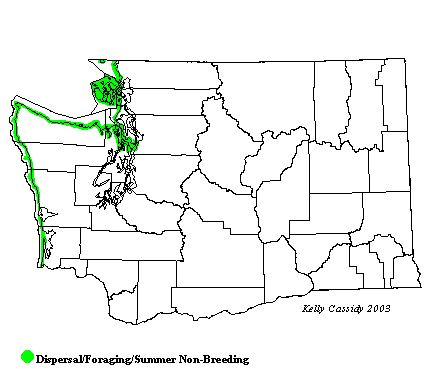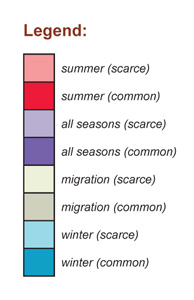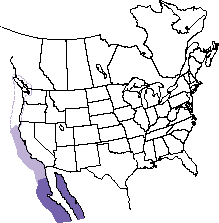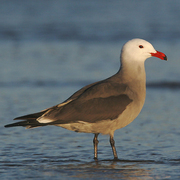Heermann's Gull
The Washington representatives of this family can be split into two groups, or subfamilies. The adaptable gulls are the most familiar. Sociable in all seasons, they are mainly coastal, but a number of species also nest inland. Many—but not all—are found around people. Gulls have highly variable foraging techniques and diets. Terns forage in flight, swooping to catch fish or insects. They dive headfirst into the water for fish. Although they are likely to be near water, they spend less time swimming than gulls.
General Description
The Heerman's Gull is the size of a Ring-billed Gull, but stockier. It is unique in that its plumage is mostly dark. The Heerman's Gull has a dark gray back and wings with a lighter gray body. The head is white with a black-tipped red bill and a dark eye. The tail is black with a white terminal band. The wing has a white trailing edge and black tips. Some individuals have a white patch at the wrist. The feet are black. The Heerman's Gull is often mistaken for a jaeger. Non-breeding adults appear similar to breeding adults, but have a dark streaked head. Juveniles are solid brown overall in their first year and solid gray in their second year. They reach maturity in their fourth year.
Habitat
A Pacific species, the Heerman's Gull nests in western Mexico, and spends the non-breeding season in marine areas. A variety of coastal habitats, including rocky shores, bays, small offshore islands, kelp beds, sandy beaches, and estuaries, are all potential roosting sites. They seldom spend time at garbage dumps or on fresh water.
Behavior
While large roosting flocks are seen, Heerman's Gulls are rarely seen flying in large flocks. These gulls are aggressive, chasing other seabirds, especially Brown Pelicans, and stealing food from them.
Diet
Fish and other small marine creatures make up the majority of the diet. Eggs, other birds, refuse, and carrion are also eaten, although Heerman's Gulls eat less refuse and carrion than do most other gull species.
Nesting
Heerman's Gulls breed in early spring in large colonies on islands off the west Mexican coast. Nests are located on level ground, a shallow scrape in the soil lightly lined with feathers, grass, or weeds. Both parents incubate the 2-3 eggs for about 4 weeks, and both feed the young. Age at first flight is not known.
Migration Status
In late May, after their early breeding season, Heerman's Gulls migrate north along the Pacific Coast. Their migration coincides with that of the Brown Pelican, from whom they often steal food. They arrive in the Northwest in mid-summer and stay through the fall, when they return to Mexico to breed. Some may also disperse south from the breeding grounds along the Mexican Coast.
Conservation Status
Heerman's Gulls are vulnerable to disturbance on their nesting islands, and fishermen sometimes harvest their eggs. Recently, it has been observed that they migrate to the Northwest earlier.
When and Where to Find in Washington
Common in coastal areas from June through October, Heerman's Gulls frequently congregate at the mouths of large rivers, and there are often large flocks at the mouth of the Columbia River. They can also be found in the Strait of Juan de Fuca and the San Juan Islands. They are fairly regular in Puget Sound in small numbers.
 Abundance
Abundance
| Ecoregion | Jan | Feb | Mar | Apr | May | Jun | Jul | Aug | Sep | Oct | Nov | Dec |
|---|---|---|---|---|---|---|---|---|---|---|---|---|
| Oceanic | ||||||||||||
| Pacific Northwest Coast | R | U | C | C | C | F | R | |||||
| Puget Trough | R | U | F | F | F | U | R | |||||
| North Cascades | ||||||||||||
| West Cascades | ||||||||||||
| East Cascades | ||||||||||||
| Okanogan | ||||||||||||
| Canadian Rockies | ||||||||||||
| Blue Mountains | ||||||||||||
| Columbia Plateau |
Washington Range Map

North American Range Map


Family Members
 Laughing GullLarus atricilla
Laughing GullLarus atricilla Franklin's GullLarus pipixcan
Franklin's GullLarus pipixcan Little GullLarus minutus
Little GullLarus minutus Black-headed GullLarus ridibundus
Black-headed GullLarus ridibundus Bonaparte's GullLarus philadelphia
Bonaparte's GullLarus philadelphia Heermann's GullLarus heermanni
Heermann's GullLarus heermanni Black-tailed GullLarus crassirostris
Black-tailed GullLarus crassirostris Short-billed GullLarus canus
Short-billed GullLarus canus Ring-billed GullLarus delawarensis
Ring-billed GullLarus delawarensis California GullLarus californicus
California GullLarus californicus Herring GullLarus argentatus
Herring GullLarus argentatus Thayer's GullLarus thayeri
Thayer's GullLarus thayeri Iceland GullLarus glaucoides
Iceland GullLarus glaucoides Lesser Black-backed GullLarus fuscus
Lesser Black-backed GullLarus fuscus Slaty-backed GullLarus schistisagus
Slaty-backed GullLarus schistisagus Western GullLarus occidentalis
Western GullLarus occidentalis Glaucous-winged GullLarus glaucescens
Glaucous-winged GullLarus glaucescens Glaucous GullLarus hyperboreus
Glaucous GullLarus hyperboreus Great Black-backed GullLarus marinus
Great Black-backed GullLarus marinus Sabine's GullXema sabini
Sabine's GullXema sabini Black-legged KittiwakeRissa tridactyla
Black-legged KittiwakeRissa tridactyla Red-legged KittiwakeRissa brevirostris
Red-legged KittiwakeRissa brevirostris Ross's GullRhodostethia rosea
Ross's GullRhodostethia rosea Ivory GullPagophila eburnea
Ivory GullPagophila eburnea Least TernSternula antillarum
Least TernSternula antillarum Caspian TernHydroprogne caspia
Caspian TernHydroprogne caspia Black TernChlidonias niger
Black TernChlidonias niger Common TernSterna hirundo
Common TernSterna hirundo Arctic TernSterna paradisaea
Arctic TernSterna paradisaea Forster's TernSterna forsteri
Forster's TernSterna forsteri Elegant TernThalasseus elegans
Elegant TernThalasseus elegans

